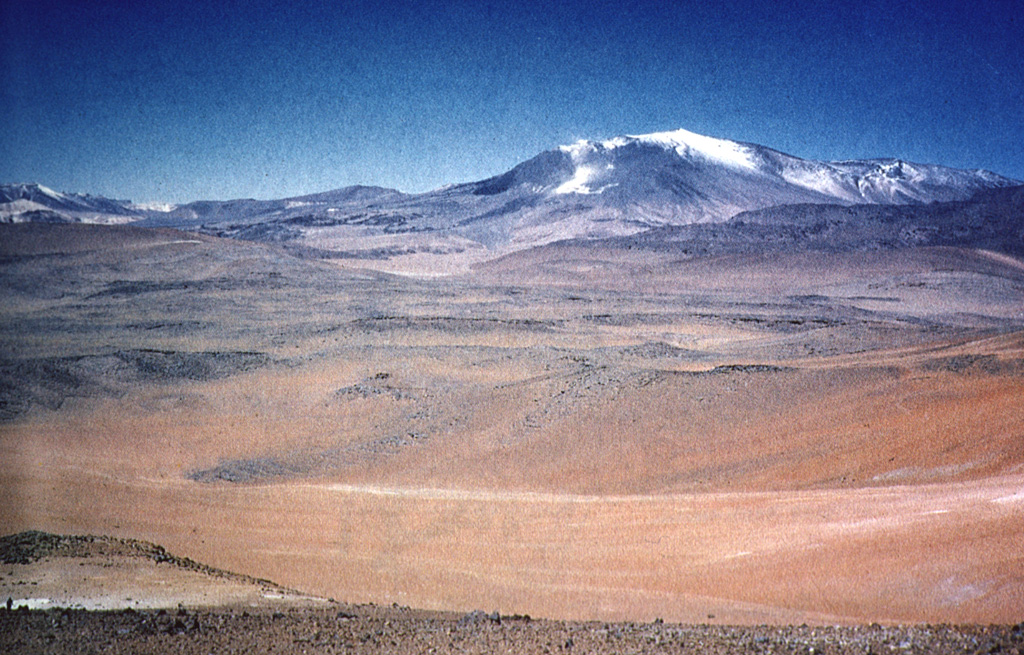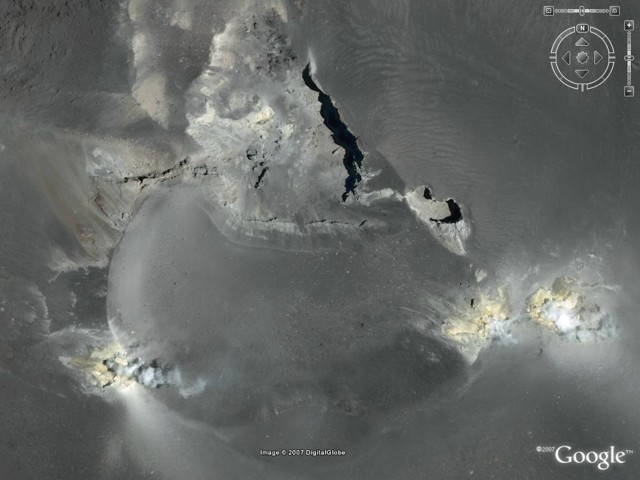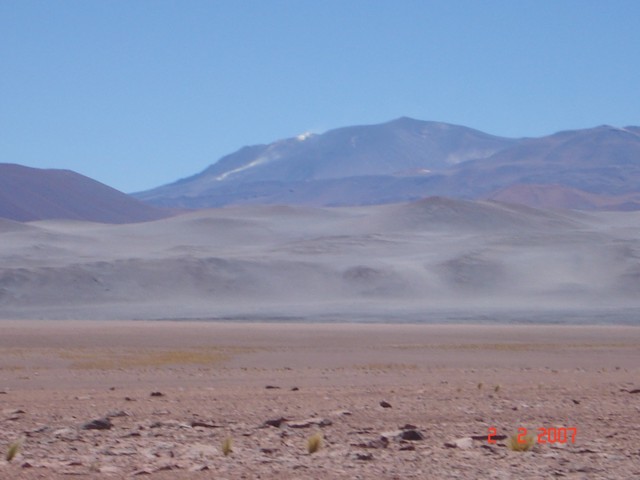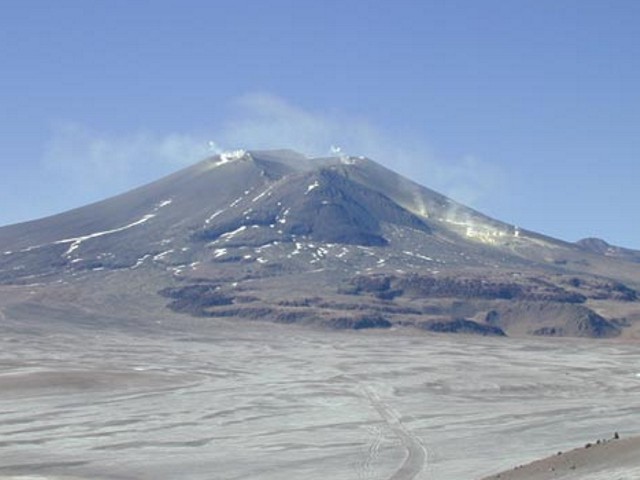

Intense fumarolic emissions typical of activity since at least 1940
The rarely visited Lastarria has not erupted in historical time, but has displayed strong fumarolic activity (figure 1) for at least 67 years. This is the first Bulletin report ever issued on this volcano; it presents new images of the steaming edifice. On 2 February 2007, a group of scientists from the Servicio Nacional de Geología y Minería (SERNAGEOMIN) and the Corporación Nacional Forestal (CONAF) observed the fumarolic activity from a distance. The scientists were on a field trip to count flamingos and other Andean birds at Ramsar sites. The Ramsar Convention on Wetlands (http://www.ramsar.org/), named after a city in Iran, is an intergovernmental treaty that provides the framework for national action and international cooperation for the conservation and wise use of wetlands and their resources. The group noted steam plumes blowing NE at mid-day from ~ 47 km SW. Fumarolic gases were again seen, from ~ 35 km WSW, slowly moving down the W slope of the cone (figure 2). Steam plumes were seen intermittently throughout the afternoon.
 |
Figure 1. Lastarria imaged by satellite on an unknown date. Fumaroles can be seen on the SW and SE crater rims. Crater width (E-W) is ~600 m. Courtesy of Google Earth and DigitalGlobe. |
 |
Figure 2. Photograph showing Lastarria from ~35 km WSW, 2 February 2007. Fumarolic gases can be seen rising above the cone and moving down the W flank. Courtesy of Héctor Cepeda. |
Jose Antonio Naranjo, who has worked at Lastarria since 1983, is very familiar with its spectacular fumarolic activity. He confirmed that the observations of February 2007 reflect Lastarria's normal intense fumarolic emissions. Such activity has continued since at least 1940, when observed by Danko Slozilo. Naranjo noted that in 2007 he saw the same fumarole locations as those he observed in 1983 and in October 2002 (figure 3). The temperatures of these fumaroles were unchanged between 1983 and 2002.
 |
Figure 3. Photograph of the Lastarria cone showing the lava dome overlapping the N crater rim and fumaroles along the rim, October 2002. View is from the N. Courtesy of Jose Antonio Naranjo. |
References. Naranjo, J.A., 1985, Sulphur flows at Lastarria volcano in the North Chilean Andes: Nature, v. 313, no. 6005, p. 778-780.
Naranjo, J.A., 1986, Geology and evolution of the Lastarria volcanic complex, north Chilean Andes: Unpublished M Phil. Thesis, The Open University, England, 157 p.
Naranjo, J.A., and Francis, P., 1987, High velocity debris avalanche at Lastarria volcano in the north Chilean Andes: Bull. Volcanol., v. 49, p. 509-514.
Naranjo, J.A., 1988, Coladas de azufre de los volcanes Lastarria y Bayo en el norte de Chile: reologia, genesis e importancia en geologia planetaria: Revista Geologica de Chile, v. 15, no. 1, p. 3-12.
Naranjo, J.A., 1992, Chemistry and petrological evolution of Lastarria volcanic complex in the north Chilean Andes: Geol. Magazine, v. 129, p. 723-740.
Information Contacts: Héctor Cepeda and Margaret Mercado, Servicio Nacional de Geología y Minería (SERNAGEOMIN), Chile; Jorge Carabantes, Cristian Rivera, Eric Díaz, and Juan Soto, Corporación Nacional Forestal (CONAF), Chile; Jose Antonio Naranjo, Volcano Hazards Programme, Servicio Nacional de Geologia y Mineria, Chile.
The Global Volcanism Program has no Weekly Reports available for Lastarria.
Reports are organized chronologically and indexed below by Month/Year (Publication Volume:Number), and include a one-line summary. Click on the index link or scroll down to read the reports.
Intense fumarolic emissions typical of activity since at least 1940
The rarely visited Lastarria has not erupted in historical time, but has displayed strong fumarolic activity (figure 1) for at least 67 years. This is the first Bulletin report ever issued on this volcano; it presents new images of the steaming edifice. On 2 February 2007, a group of scientists from the Servicio Nacional de Geología y Minería (SERNAGEOMIN) and the Corporación Nacional Forestal (CONAF) observed the fumarolic activity from a distance. The scientists were on a field trip to count flamingos and other Andean birds at Ramsar sites. The Ramsar Convention on Wetlands (http://www.ramsar.org/), named after a city in Iran, is an intergovernmental treaty that provides the framework for national action and international cooperation for the conservation and wise use of wetlands and their resources. The group noted steam plumes blowing NE at mid-day from ~ 47 km SW. Fumarolic gases were again seen, from ~ 35 km WSW, slowly moving down the W slope of the cone (figure 2). Steam plumes were seen intermittently throughout the afternoon.
 |
Figure 1. Lastarria imaged by satellite on an unknown date. Fumaroles can be seen on the SW and SE crater rims. Crater width (E-W) is ~600 m. Courtesy of Google Earth and DigitalGlobe. |
 |
Figure 2. Photograph showing Lastarria from ~35 km WSW, 2 February 2007. Fumarolic gases can be seen rising above the cone and moving down the W flank. Courtesy of Héctor Cepeda. |
Jose Antonio Naranjo, who has worked at Lastarria since 1983, is very familiar with its spectacular fumarolic activity. He confirmed that the observations of February 2007 reflect Lastarria's normal intense fumarolic emissions. Such activity has continued since at least 1940, when observed by Danko Slozilo. Naranjo noted that in 2007 he saw the same fumarole locations as those he observed in 1983 and in October 2002 (figure 3). The temperatures of these fumaroles were unchanged between 1983 and 2002.
 |
Figure 3. Photograph of the Lastarria cone showing the lava dome overlapping the N crater rim and fumaroles along the rim, October 2002. View is from the N. Courtesy of Jose Antonio Naranjo. |
References. Naranjo, J.A., 1985, Sulphur flows at Lastarria volcano in the North Chilean Andes: Nature, v. 313, no. 6005, p. 778-780.
Naranjo, J.A., 1986, Geology and evolution of the Lastarria volcanic complex, north Chilean Andes: Unpublished M Phil. Thesis, The Open University, England, 157 p.
Naranjo, J.A., and Francis, P., 1987, High velocity debris avalanche at Lastarria volcano in the north Chilean Andes: Bull. Volcanol., v. 49, p. 509-514.
Naranjo, J.A., 1988, Coladas de azufre de los volcanes Lastarria y Bayo en el norte de Chile: reologia, genesis e importancia en geologia planetaria: Revista Geologica de Chile, v. 15, no. 1, p. 3-12.
Naranjo, J.A., 1992, Chemistry and petrological evolution of Lastarria volcanic complex in the north Chilean Andes: Geol. Magazine, v. 129, p. 723-740.
Information Contacts: Héctor Cepeda and Margaret Mercado, Servicio Nacional de Geología y Minería (SERNAGEOMIN), Chile; Jorge Carabantes, Cristian Rivera, Eric Díaz, and Juan Soto, Corporación Nacional Forestal (CONAF), Chile; Jose Antonio Naranjo, Volcano Hazards Programme, Servicio Nacional de Geologia y Mineria, Chile.
|
|
||||||||||||||||||||||||||
The Global Volcanism Program is not aware of any Holocene eruptions from Lastarria. If this volcano has had large eruptions (VEI >= 4) prior to 12,000 years ago, information might be found on the Lastarria page in the LaMEVE (Large Magnitude Explosive Volcanic Eruptions) database, a part of the Volcano Global Risk Identification and Analysis Project (VOGRIPA).
This compilation of synonyms and subsidiary features may not be comprehensive. Features are organized into four major categories: Cones, Craters, Domes, and Thermal Features. Synonyms of features appear indented below the primary name. In some cases additional feature type, elevation, or location details are provided.
Synonyms |
| Atacama, Volcán de | Azufre, Cerro de |
There are no samples for Lastarria in the Smithsonian's NMNH Department of Mineral Sciences Rock and Ore collection.
| Copernicus Browser | The Copernicus Browser replaced the Sentinel Hub Playground browser in 2023, to provide access to Earth observation archives from the Copernicus Data Space Ecosystem, the main distribution platform for data from the EU Copernicus missions. |
| MIROVA | Middle InfraRed Observation of Volcanic Activity (MIROVA) is a near real time volcanic hot-spot detection system based on the analysis of MODIS (Moderate Resolution Imaging Spectroradiometer) data. In particular, MIROVA uses the Middle InfraRed Radiation (MIR), measured over target volcanoes, in order to detect, locate and measure the heat radiation sourced from volcanic activity. |
| MODVOLC Thermal Alerts | Using infrared satellite Moderate Resolution Imaging Spectroradiometer (MODIS) data, scientists at the Hawai'i Institute of Geophysics and Planetology, University of Hawai'i, developed an automated system called MODVOLC to map thermal hot-spots in near real time. For each MODIS image, the algorithm automatically scans each 1 km pixel within it to check for high-temperature hot-spots. When one is found the date, time, location, and intensity are recorded. MODIS looks at every square km of the Earth every 48 hours, once during the day and once during the night, and the presence of two MODIS sensors in space allows at least four hot-spot observations every two days. Each day updated global maps are compiled to display the locations of all hot spots detected in the previous 24 hours. There is a drop-down list with volcano names which allow users to 'zoom-in' and examine the distribution of hot-spots at a variety of spatial scales. |
|
WOVOdat
Single Volcano View Temporal Evolution of Unrest Side by Side Volcanoes |
WOVOdat is a database of volcanic unrest; instrumentally and visually recorded changes in seismicity, ground deformation, gas emission, and other parameters from their normal baselines. It is sponsored by the World Organization of Volcano Observatories (WOVO) and presently hosted at the Earth Observatory of Singapore.
GVMID Data on Volcano Monitoring Infrastructure The Global Volcano Monitoring Infrastructure Database GVMID, is aimed at documenting and improving capabilities of volcano monitoring from the ground and space. GVMID should provide a snapshot and baseline view of the techniques and instrumentation that are in place at various volcanoes, which can be use by volcano observatories as reference to setup new monitoring system or improving networks at a specific volcano. These data will allow identification of what monitoring gaps exist, which can be then targeted by remote sensing infrastructure and future instrument deployments. |
| Volcanic Hazard Maps | The IAVCEI Commission on Volcanic Hazards and Risk has a Volcanic Hazard Maps database designed to serve as a resource for hazard mappers (or other interested parties) to explore how common issues in hazard map development have been addressed at different volcanoes, in different countries, for different hazards, and for different intended audiences. In addition to the comprehensive, searchable Volcanic Hazard Maps Database, this website contains information about diversity of volcanic hazard maps, illustrated using examples from the database. This site is for educational purposes related to volcanic hazard maps. Hazard maps found on this website should not be used for emergency purposes. For the most recent, official hazard map for a particular volcano, please seek out the proper institutional authorities on the matter. |
| IRIS seismic stations/networks | Incorporated Research Institutions for Seismology (IRIS) Data Services map showing the location of seismic stations from all available networks (permanent or temporary) within a radius of 0.18° (about 20 km at mid-latitudes) from the given location of Lastarria. Users can customize a variety of filters and options in the left panel. Note that if there are no stations are known the map will default to show the entire world with a "No data matched request" error notice. |
| UNAVCO GPS/GNSS stations | Geodetic Data Services map from UNAVCO showing the location of GPS/GNSS stations from all available networks (permanent or temporary) within a radius of 20 km from the given location of Lastarria. Users can customize the data search based on station or network names, location, and time window. Requires Adobe Flash Player. |
| DECADE Data | The DECADE portal, still in the developmental stage, serves as an example of the proposed interoperability between The Smithsonian Institution's Global Volcanism Program, the Mapping Gas Emissions (MaGa) Database, and the EarthChem Geochemical Portal. The Deep Earth Carbon Degassing (DECADE) initiative seeks to use new and established technologies to determine accurate global fluxes of volcanic CO2 to the atmosphere, but installing CO2 monitoring networks on 20 of the world's 150 most actively degassing volcanoes. The group uses related laboratory-based studies (direct gas sampling and analysis, melt inclusions) to provide new data for direct degassing of deep earth carbon to the atmosphere. |
| Large Eruptions of Lastarria | Information about large Quaternary eruptions (VEI >= 4) is cataloged in the Large Magnitude Explosive Volcanic Eruptions (LaMEVE) database of the Volcano Global Risk Identification and Analysis Project (VOGRIPA). |
| EarthChem | EarthChem develops and maintains databases, software, and services that support the preservation, discovery, access and analysis of geochemical data, and facilitate their integration with the broad array of other available earth science parameters. EarthChem is operated by a joint team of disciplinary scientists, data scientists, data managers and information technology developers who are part of the NSF-funded data facility Integrated Earth Data Applications (IEDA). IEDA is a collaborative effort of EarthChem and the Marine Geoscience Data System (MGDS). |